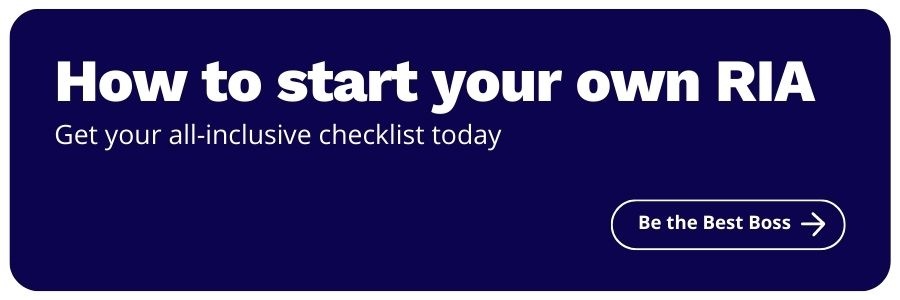Do's & Don'ts for Building Your Firm's Website
Share this
Building your website is essential to launching—and growing—your financial planning firm. Your website is the key platform for promoting your RIA to the world. It’s well-known that today’s consumers are more informed before engaging with a company—what your website says about your firm is critical to converting site visitors into leads.
Building a website from scratch doesn’t have to be a daunting task. Investing time in some upfront planning will set you up for success and help you avoid common stumbling blocks.
If you already have a website, these tips may help you evaluate your current structure or create any additional pages.
The Do’s
Determine Your NeedsWhen you’re faced with a big and/or unfamiliar task, it can sometimes seem better to charge ahead and figure it out as you go. I love the enthusiasm—but you will be happier with the end product if you take a little time before you jump in.
Unless you’re also a backend developer and can code your own site, you’ll need to choose a platform on which to build. I’ve seen XYPN members use SquareSpace, WordPress, and Drupal. These platforms offer a range of customizable website templates, making them a user-friendly and economical option if you’re comfortable with DIY.
If you aren’t the Joanna Gaines of websites, your other option is to hire this out. Before you sign up with a firm or designer, do your homework. Review other sites they have built. If you don’t like what you see, you probably won’t like the site they build for you. Confirm you will own the site and content. Understand how updates will be managed—will you have access (and the know-how) to make changes or will you forever be reliant on the firm/designer? If you don’t have a logo and brand identity, can they also create these for you?
This is also the time to start thinking about any functionality you need or want to ensure your website platform can support it. If you’re using a CRM, does it have form functionality for capturing contact information and can that be embedded in your website? Are you're using a meeting schedule tool and can that be embedded? Were you hoping to have a live chat feature?
There are endless possibilities and plugins so I encourage you to focus on what will help you run your business better (like compatibility between your CRM forms and your website) and save the other fun items as possible future additions.
Armed with your platform of choice, your designer (whether that’s you or someone else), and your key functionality, you’re ready to start thinking about what will actually be on your site.
Create a Content PlanBefore you even think about creating your first page on your website platform, I implore you to first create a content plan. It will save you the headache (and heartache) of building pages that never seem to be quite right or ones you never end up publishing.
A content plan provides a clear organization of your most important messages, calls-to-action (CTAs), and website structure. It’s where you identify not only what pages will be on your site, but what you’re going to communicate on those pages and how.
When building sites from scratch, I like to use this website content plan template. I built this to help define the site structure, the purpose and focus for each page, and page goals (i.e. the action you want visitors to take). You’ll notice there is also an area to identify supporting images or graphics. A website is so much more than a collection of words on a page—images are critical for helping convey your message and even invoking emotions in your site visitors. There are a number of free photo sites available and I’ve also seen advisors incorporate their own images (from travel, of their office, or their families).
Once you have a clear plan of the pages and messaging, I recommend creating a Word or Google doc with the full content for each page. This is a much easier format for writing and copyediting. As your content comes together, you’ll begin to see natural groupings or clusters that can help you visualize how to position it within a page.
Be TransparentIf you’re even a little bit familiar with our co-founders, Alan Moore and Michael Kitces, this DO will be no surprise. As you’re building your content plan, I encourage you to be transparent and include your fees on your site.
I know there can be hesitation to publicize your fees without being able to have a conversation about the value you provide. I encourage you to think about this as an opportunity for website content—how can you sell yourself through the content on your site and educate your prospects? I’ve seen some advisors do this successfully through video, either talking specifically about their firm or speaking more generally about fee-only planning—what it is, why it’s valuable, and how it makes financial planning more accessible.
I’d also challenge you to reframe how you think about sharing your fees. Yes, there may be some site visitors who choose not to engage with you after seeing prices. Instead of looking at that as a negative, think about how that frees up your time to focus on prospects who are ready to engage. When you’re starting out, it can seem like a conversation with anyone is a step in the right direction.
Ask any advisor and they will tell you, not every prospect is the right fit. Sometimes this is because their planning needs don’t align with your niche or expertise, and sometimes it’s because the client doesn’t (and may never) see the value behind the cost. Is it a better investment of your time and energy to try to win over the individual who isn’t willing to pay your fees or to go after those who are aware of the costs and still have the interest?
Choose Your Domain Wisely
Our Senior Director of Marketing, Jen Mastrud, listed this as the #1 must-have for your firm’s website. If you have not yet launched your firm, I echo her recommendation to check if your desired domain is available before you register your business name.
The most important thing is for it to be intuitive for prospects and clients. Most commonly, your website domain is your businessname.com.
Domains are relatively inexpensive. If you have the budget, I would recommend purchasing the common variations of your domain as well and redirecting them to the main domain you plan to use.
If your firm name is Goldendoodle Financial Planning, you may want to purchase goldendoodlefinancial.com and goldendoodlefinancialplanning.com. Choose one of them to be the domain you use for your website, and set the other one to redirect to that primary domain. Purchasing similar domains not only protects your brand but also helps drive traffic to your website if there are a few logical options for how someone might be searching for your business.
Track Key MetricsI’ve written a few other blogs for XYPN, and I probably mention tracking in some fashion in each of them. If you don’t track what you’re doing, how can you know if your efforts are successful?
At a minimum, install Google Analytics on your website. It’s free and gives you insight into what pages people are visiting, how long they are staying, and from which pages they are leaving your site.
If putting your pricing out there makes you cringe (Do #3), exit page data will tell you if people are leaving your site from your services/pricing page at a high rate. Caveat: if you find that is the case, it doesn’t necessarily mean you should remove your fees. You may need to explore how you’re positioning your value or whether the right audience is getting to your site.
If you want more extensive tracking, Google’s Campaign URL Builder can help you easily create tracking URLs so you can see which of your CTAs are driving the most engagement.
Google Tag Manager is like the campaign URL builder on steroids—once you install the GTM snippet on your site, you can set up triggers and tags to track just about any action you can imagine.
And if you love seeing how a visitor is interacting with your site, HotJar is a heatmapping tool that provides insight into things like how far down on a page visitors will scroll, where visitors are dropping off, and even capture recordings of real visitors to understand their movements.
Don’t Forget To…
Make the Focus About Your Ideal ClientYes, you want to communicate what makes your firm amazing and the wealth of knowledge you have in financial planning. But you want to frame it in a way that tells your site visitors how your expertise will directly help them.
It’s human nature to consume information in the lens of how it pertains to you. The last time you heard the weather report, was your first thought, "Oh, how lovely for the kids next door to be able to play outside"? I’m guessing it was more along the lines of, "Great, I can wear sandals to the store and I should probably water my flowers."
Your message is more likely to resonate with a site visitor if they can see how you services will directly impact them. From the second your ideal client hits your site, it should be abundantly clear this is the place for them.
To use my fictitious firm Goldendoodle Financial Planning, this means my primary imagery should portray my ideal client (a picture of a couple or family with a Goldendoodle) and any complimentary text should very clearly indicate my firm’s focus ( Goldendoodle Financial Planning, providing fur-focused financial advice for Goldendoodle owners.)
Here's a helpful exercise I like to work through. Put someone in front of the computer with their eyes closed. Navigate to your site, have them open their eyes, and ask them for their immediate thoughts and feelings. Within those first few seconds, they should be able to guess your niche (or get pretty darn close).
Set Clear Expectations and Deliver On ThemA website is more than a collection of text and images—it’s an experience. Part of crafting a good experience for your site visitors is setting expectations for what they will find and how, and then delivering against those expectations.
Months ago I was at the grocery store looking for cardamom for a new recipe. I immediately went to the spice and baking aisle because that’s where I expected it to be. Having no luck, I went to the produce section and looked by the fresh herbs, but was again unsuccessful. From there I wandered around some endcaps, went to the organic food section, swung through the international food area, and Googled cardamom from my phone to see if I could get any idea where I might find it. I eventually gave up, paid for the groceries I had, and left. (Ironically, as I was leaving the store, between the ATM and baskets was a rack of dried spices with my desired cardamom. I was so annoyed it wasn’t where I thought it should be I didn’t go back to get it and haven’t picked it up since.)
This long anecdote is more than an illustration of my stubbornness. If a site visitor navigates to a page titled "Services", their expectation is they will gain an understanding of what you can provide to them. If you take the first half of the page to talk about the credentials and experiences that ultimately make you qualified to perform these services, you aren’t meeting their expectation. If they tough it out, they may eventually get to your services information, but given the declining attention span, you’re likely to lose more visitors than you’ll retain. If a site visitor leaves out of frustration, you are unlikely to get them back.
This is another case for creating a content plan (Do #2). By taking the time to organize the information on your site, you can align the information within your pages to meet the expectations you are setting.
Get FeedbackBefore you launch your site to the public, it’s a good idea to have someone else take a look and give you feedback. This is especially true if you built your site; getting an outside perspective will help you overcome any blind spots you may have in the content or design.
Feedback doesn’t have to come from a professional web developer. XYPN mastermind or launcher groups offer a great community of peers with whom you can share your site. Other good candidates include professionals in your network, your ideal client, your spouse, or the kid down the street. You can even hire a drunk guy to do it.
The goal of getting feedback is not to get your site ready for some UX award—it’s to see if a regular person can easily navigate and understand it. When you have someone look at your site, ask them for their feedback on the following:
- What were your thoughts and feelings when you first arrived on the site? Did you feel like this was for you?
- From the initial impression, were you interested enough to want to find out more?
- Were you able to find the information you were looking for and did you find it where you expected to?
- Did you leave with any questions? Was anything confusing?
Your firm’s website is essential to your business, but doubling as a UX designer or developer is not essential to “getting it right.” Follow these simple do's and don'ts and you'll be well on your way to a website that not only looks good, but that actually delivers results.
 About the Author
About the Author
As XYPN’s Webmaster, Katie DeMars plays a major role in communicating XYPN’s value proposition to the world through digital mediums. Her career experiences span marketing and web roles giving her a unique perspective when approaching each project. Katie is passionate about creating exceptional virtual experiences and is excited to share XYPN’s story through digital platforms.
Share this
- Running Your RIA Efficiently: Outsourcing Bookkeeping with XYPN Books
- Road to Launch with XYPN Member Alan Skillern, CFP®, MBA
- Coaching for Better Time Management: Prioritizing Organic Growth in Your Daily Routine
- Boost Your Financial Advisory Practice: SEO Strategies and CRM Optimization for Sales Success
- Advisor Blog (693)
- Financial Advisors (221)
- Growing an RIA (99)
- Digital Marketing (87)
- Marketing (84)
- Community (81)
- Start an RIA (76)
- Business Development (72)
- Coaching (72)
- Running an RIA (70)
- Compliance (69)
- Client Acquisition (65)
- Technology (64)
- XYPN LIVE (59)
- Entrepreneurship (57)
- Sales (49)
- Practice Management (44)
- Client Engagement (41)
- Bookkeeping (38)
- XYPN Books (38)
- Investment Management (37)
- Fee-only advisor (36)
- Lifestyle, Family, & Personal Finance (31)
- Employee Engagement (30)
- Client Services (25)
- Financial Education & Resources (25)
- Journey Makers (21)
- Market Trends (21)
- Process (14)
- Niche (11)
- SEO (9)
- Scaling an RIA (9)
- Career Change (8)
- Transitioning Your Business (7)
- Partnership (6)
- Transitioning To Fee-Only (4)
- Social Media (3)
- Transitioning Clients (3)
- Emerald (2)
- Persona (2)
- RIA (2)
- Onboarding (1)
- Sapphire (1)
Subscribe by email
You May Also Like
These Related Stories

The Anatomy of a High-Converting Website
Nov 5, 2020
4 min read

A Winning Website: How to Convert your Firm's Website Visitors to Leads
Nov 22, 2021
7 min read





